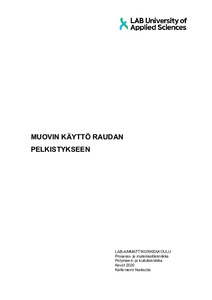Muovin käyttö raudan pelkistykseen
Kallioniemi, Nadezda (2020)
Kallioniemi, Nadezda
2020
Julkaisun pysyvä osoite on
https://urn.fi/URN:NBN:fi:amk-2020060917858
https://urn.fi/URN:NBN:fi:amk-2020060917858
Tiivistelmä
Terästeollisuus on jatkuvasti kasvava teollisuudenala. Teräksen kysyntä maailmalla on kasvanut infrastruktuurien rakentamisen myötä. Terästeollisuus tuottaa tällä hetkellä suuria määriä hiilidioksidipäästöjä. Raudan valmistukseen on käytetty hiiltä, mutta kiristyvien lainsäädäntöjen myötä vedyn käyttöä pelkistykseen on otettu kokeiluun.
Opinnäytetyössä selvitettiin mahdollisuutta raudan pelkistyksessä käytettävän koksin korvaamista muovilla. Työn tarkoitus oli kokeilla käytännössä, onnistuuko pelkistyminen muovilla ja samalla testata tekstiilin soveltuvuutta pelkistäjämateriaaliksi. Muovi- ja tekstiilimateriaalia on runsaasti tarjolla maailmalla. Opinnäytetyön toimeksiantaja on LAB- ammattikorkeakoulu.
Teoriaosuudessa käytiin läpi yleisesti raudan valmistusvaiheita ja kierrätyksen kannalta ongelmallisten materiaalien ominaisuuksia. Selvitettiin myös niiden hyödyntäminen raaka-aineena raudan pelkistysprosessissa.
Käytännön työn osuudessa testimateriaaleina olivat polyeteeni ja polyesteri sekoitekuidut. Näytteet laitettiin posliiniupokkaisiin rautaoksidin kanssa ja pelkistettiin muhveliuunissa korkeassa lämpötilassa. Tulokseksi tuli rautamuruja, jotka reagoivat magneettiin. The steel industry is a constantly growing industry. Global demand for steel has increased with the construction of infrastructure. The steel industry currently emits large amounts of carbon dioxide. Coal has been used to make iron, but with the tightening of legislation, the use of hydrogen for reduction has been experimented.
The possibility of replacing coke used in iron reduction with plastic was investigated in this Bachelor’s thesis. The purpose of the work was to test in practice whether the reduction with plastic is successful and at the same time to test the suitability of the textile as a reducing material. Plastic and textile materials are abundant in the world. The thesis is commissioned by LAB University of Applied Sciences.
In the theoretical part are process of ironmaking and the properties of materials, that are problematic from the recycling point of view, were reviewed. Their utilization as a raw material in the iron reduction process was also investigated.
In the practical part, the test materials were polyethylene and polyester blend fibers. The samples were placed in porcelain crucibles with iron oxide and reduced in a muffle furnace at high temperature. The results were iron crumbs that reacted to the magnet.
Opinnäytetyössä selvitettiin mahdollisuutta raudan pelkistyksessä käytettävän koksin korvaamista muovilla. Työn tarkoitus oli kokeilla käytännössä, onnistuuko pelkistyminen muovilla ja samalla testata tekstiilin soveltuvuutta pelkistäjämateriaaliksi. Muovi- ja tekstiilimateriaalia on runsaasti tarjolla maailmalla. Opinnäytetyön toimeksiantaja on LAB- ammattikorkeakoulu.
Teoriaosuudessa käytiin läpi yleisesti raudan valmistusvaiheita ja kierrätyksen kannalta ongelmallisten materiaalien ominaisuuksia. Selvitettiin myös niiden hyödyntäminen raaka-aineena raudan pelkistysprosessissa.
Käytännön työn osuudessa testimateriaaleina olivat polyeteeni ja polyesteri sekoitekuidut. Näytteet laitettiin posliiniupokkaisiin rautaoksidin kanssa ja pelkistettiin muhveliuunissa korkeassa lämpötilassa. Tulokseksi tuli rautamuruja, jotka reagoivat magneettiin.
The possibility of replacing coke used in iron reduction with plastic was investigated in this Bachelor’s thesis. The purpose of the work was to test in practice whether the reduction with plastic is successful and at the same time to test the suitability of the textile as a reducing material. Plastic and textile materials are abundant in the world. The thesis is commissioned by LAB University of Applied Sciences.
In the theoretical part are process of ironmaking and the properties of materials, that are problematic from the recycling point of view, were reviewed. Their utilization as a raw material in the iron reduction process was also investigated.
In the practical part, the test materials were polyethylene and polyester blend fibers. The samples were placed in porcelain crucibles with iron oxide and reduced in a muffle furnace at high temperature. The results were iron crumbs that reacted to the magnet.
